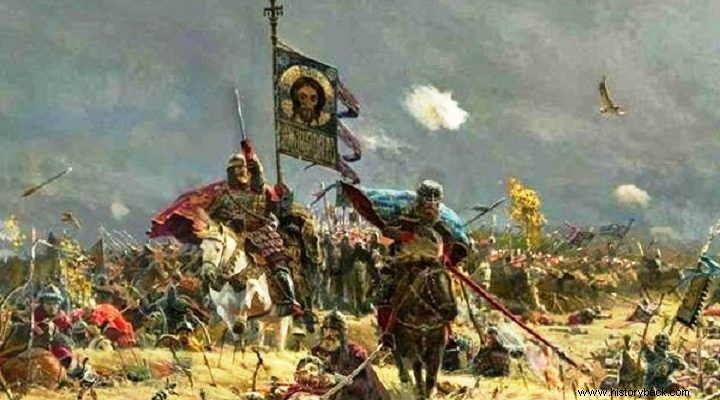
The Russian Army of the 16th century did not differ substantially, but only slightly, from its counterparts of the 14th and 15th centuries. Its bulk consisted of cavalry, native and mercenary divisions. The Cavalry was, in principle, divided into heavy and light. The heavy cavalry, in turn, was mainly made up of boyars.
Every Russian noble with a land area of more than 2.7 hectares was obliged to provide military service to the tsar. For this purpose he had to have at least one war horse and the same weapons and supplies. For every additional 2.7 hectares of land this noble had to equip one more mounted follower. Usually every noble horseman brought with him two or more war horses.
It is understood that the very powerful boyar families, who owned vast tracts of land, were capable of raising entire armies, on behalf of the state, supposedly, but also for the defense of the same interests, when required.
The heavy cavalry, until the time of Ivan, consisted of two bodies, the body of the Dvors and the Deti Boyarskis. The Dvors were noble horsemen who were paid for their services by the state, either in money or by the grant of land. Each time, the favored boyars of each tsar joined this corps. These men made up the tsar's guard, as it were.
The Deti Boyarskis (sons of boyars) made up the bulk of the tsars' cavalry. The men of this corps were the followers of the boyars, who were armed by the nobles, as already mentioned. This body, later, also included rich citizens, who had property equal in value to the landed property of the boyars, together with their own followers.
On the contrary, the Christian Cossacks, who were gradually integrated into Russian society, although they were also mercenaries, essentially, developed special ties with the Russians and were a key tool of the Russian war machine, until the collapse of the tsarist regime.>
Armament
In terms of its armament, the Russian heavy cavalry carried mainly "oriental" armament and equipment. Russian heavy horsemen were equipped with a compound bow, a curved sword, a short spear, which was also used as a javelin or a kind of lance, and a manual.
Some very rich people, from the middle of the 16th century, also carried pistols. As for their armour, it was similar to that of their Ottoman and Tatar opponents, with oriental-style helmets, chain mail, breastplates reinforced with metal plates, greaves and cuffs. The helmets were usually also worn with a chain katauchene.
The main weapon of heavy cavalry it was the compound bow, made of wood and animal horns , which had a maximum range of about 600 meters, with the so-called hunting arrow , although it was rarely used at distances of more than 100 meters – with the so-called war arrow. The war arrows were about 61 cm long, compared to 90 cm. of those used in hunting.
War arrows could sustain 12.7mm thick wood. at a distance of 100 meters. Hunting arrows were also used in war, in the initial phases of the battle, due to their superior range. However, they could not hit a sufficiently armored target.
The horsemen were also equipped with a type of lance, of short length, which could end in a common point and be used as a heavy javelin, or end in a sickle-shaped point. The horseman could also carry light, short javelins, corresponding to the Byzantine "riptaria", which, three each, were carried in a special pouch, hung on the left side of the horseman's belt.
Another popular weapon among the nobility was various types of iron clubs (head-breakers). Finally, the horseman's equipment was completed by the long, curved, eastern-type sword (yatagani). Some horsemen used straight, long swords.
Light cavalry and Cossacks
The light cavalry of the Russian armies of the time were numerous and came from the neighboring peoples, either the Cossacks or the Tatars. Tatars, Muslims in religion, served as mercenaries in the Russian armies, but not when the Russians were fighting against their own sex.
Cossacks were equipped, originally equipped, with bows and swords. Later they were equipped with short-barreled muskets or arquebuses. The Cossacks served in the same units, with their own leaders. The Tartar mercenaries, finally, were equipped with compound bows and swords.
